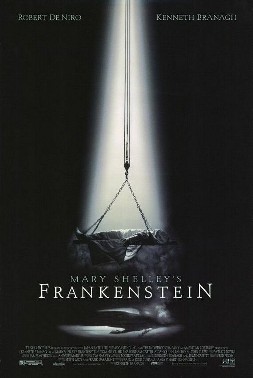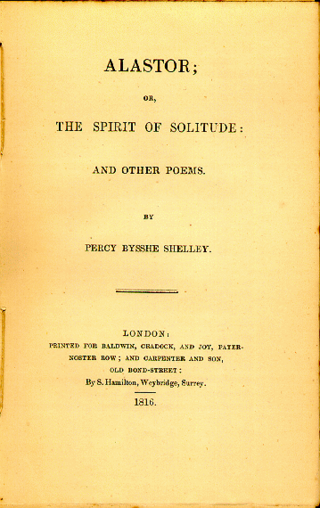
John William Polidori was a British writer and physician. He is known for his associations with the Romantic movement and credited by some as the creator of the vampire genre of fantasy fiction. His most successful work was the short story "The Vampyre" (1819), the first published modern vampire story. Although the story was at first erroneously credited to Lord Byron, both Byron and Polidori affirmed that the author was Polidori.

In Greek mythology, Prometheus is one of the Titans and a god of fire. Prometheus is best known for defying the Olympian gods by taking fire from them and giving it to humanity in the form of technology, knowledge and, more generally, civilization.

Frankenstein's monster, also referred to as Frankenstein, is a fictional character that first appeared in Mary Shelley's 1818 novel Frankenstein; or, The Modern Prometheus as its main antagonist. Shelley's title compares the monster's creator, Victor Frankenstein, to the mythological character Prometheus, who fashioned humans out of clay and gave them fire.

Twelfth Night, or What You Will is a romantic comedy by William Shakespeare, believed to have been written around 1601–1602 as a Twelfth Night entertainment for the close of the Christmas season. The play centres on the twins Viola and Sebastian, who are separated in a shipwreck. Viola falls in love with the Duke Orsino, who in turn is in love with Countess Olivia. Upon meeting Viola, Countess Olivia falls in love with her, thinking she is a man.

Mary Shelley's Frankenstein is a 1994 science fiction horror film directed by Kenneth Branagh who also stars as Victor Frankenstein, with Robert De Niro portraying Frankenstein's monster, and co-stars Tom Hulce, Helena Bonham Carter, Ian Holm, John Cleese, Richard Briers and Aidan Quinn. Considered the most faithful film adaptation of Mary Shelley's 1818 novel, Frankenstein; or, The Modern Prometheus, despite several differences and additions in plot from the novel, the film follows a medical student named Victor Frankenstein who creates new life in the form of a monster composed of various corpses' body parts.

Victor Frankenstein is a fictional character and the main protagonist and title character in Mary Shelley's 1818 novel, Frankenstein; or, The Modern Prometheus. He is a Swiss scientist who, after studying chemical processes and the decay of living things, gains an insight into the creation of life and gives life to his own creature. Victor later regrets meddling with nature through his creation, as he inadvertently endangers his own life and the lives of his family and friends when the creature seeks revenge against him. He is first introduced in the novel when he is seeking to catch the monster near the North Pole and is saved from near death by Robert Walton and his crew.
The Frankenstein complex is a term coined by Isaac Asimov in his robot series, referring to the fear of mechanical men.
Prometheus is a figure in Greek mythology.

Mary Shelley's 1818 novel Frankenstein; or, The Modern Prometheus, and the famous character of Frankenstein's monster, have influenced popular culture for at least a century. The work has inspired numerous films, television programs, video games and derivative works. The character of the Monster remains one of the most recognized icons in horror fiction.

Subtitles are texts representing the contents of the audio in a film, television show, opera or other audiovisual media. Subtitles might provide a transcription or translation of spoken dialogue. Although naming conventions can vary, captions are subtitles that include written descriptions of other elements of the audio, like music or sound effects. Captions are thus especially helpful to people who are deaf or hard-of-hearing. Subtitles may also add information that is not present in the audio. Localizing subtitles provide cultural context to viewers. For example, a subtitle could be used to explain to an audience unfamiliar with sake that it is a type of Japanese wine. Lastly, subtitles are sometimes used for humor, as in Annie Hall, where subtitles show the characters' inner thoughts, which contradict what they were saying in the audio.
The German name Frankenstein most commonly refers to various aspects of a 19th-century novel written by Mary Shelley, but was originally a place name.

Frankenstein is a 2004 American television miniseries based on the 1818 novel Frankenstein; or, The Modern Prometheus by Mary Shelley.

Frankenstein; or, The Modern Prometheus is an 1818 novel written by English author Mary Shelley. Frankenstein tells the story of Victor Frankenstein, a young scientist who creates a sapient creature in an unorthodox scientific experiment. Shelley started writing the story when she was 18, and the first edition was published anonymously in London on 1 January 1818, when she was 20. Her name first appeared in the second edition, which was published in Paris in 1821.

Mary Wollstonecraft Shelley was an English novelist who is best known for writing the Gothic novel Frankenstein; or, The Modern Prometheus (1818), which is considered an early example of science fiction. She also edited and promoted the works of her husband, the Romantic poet and philosopher Percy Bysshe Shelley. Her father was the political philosopher William Godwin and her mother was the philosopher and women's rights advocate Mary Wollstonecraft.

"Mutability" is a poem by Percy Bysshe Shelley which appeared in the 1816 collection Alastor, or The Spirit of Solitude: And Other Poems. Half of the poem is quoted in his wife Mary Shelley's novel Frankenstein; or, The Modern Prometheus (1818) although his authorship is not acknowledged, while the 1816 poem by Leigh Hunt is acknowledged with the name of the author given. Only Percy Bysshe Shelley is not acknowledged as an author. There is also a prose version or further elaboration of the same themes of the poem in Frankenstein that immediately precedes the quotation of the poem.
English writer Lord Byron has been mentioned in numerous media. A few examples of his appearances in literature, film, music, television and theatre are listed below.

The Bride of Frankenstein is a fictional character first introduced in Mary Shelley's 1818 novel Frankenstein; or, The Modern Prometheus and later in the 1935 film Bride of Frankenstein. In the film, the Bride is played by Elsa Lanchester. The character's design in the film features a conical hairdo with white lightning-trace streaks on each side, which has become an iconic symbol of both the character and the film.

Tales of Frankenstein is an unsold TV pilot filmed in 1958. It was a co-production of Hammer Film Productions and Columbia Pictures. The film is a mixture of elements from both the Hammer and Universal Pictures versions of Frankenstein, based on Mary Shelley's 1818 novel Frankenstein; or, The Modern Prometheus. The episode title, which does not appear onscreen, is "The Face in the Tombstone Mirror". The film is in the public domain.
"The Haunting of Villa Diodati" is the eighth episode of the twelfth series of the British science fiction television programme Doctor Who, first broadcast on BBC One on 16 February 2020. It was written by Maxine Alderton, and directed by Emma Sullivan. The episode stars Jodie Whittaker as the Thirteenth Doctor, alongside Bradley Walsh, Tosin Cole and Mandip Gill as her companions, Graham O'Brien, Ryan Sinclair and Yasmin Khan, respectively. The episode is about the historical origins of the 1818 novel Frankenstein; or, The Modern Prometheus by Mary Shelley, portrayed by Lili Miller, and takes place at the Villa Diodati in 1816 where she was inspired to write the work. The episode also featured the return of the Cybermen in their first television appearance since the tenth series finale "The Doctor Falls" (2017). The episode was watched by 5.07 million viewers, and received positive reviews from critics.

An alternative title or alternate title in book publishing refers to the usage of "or" in book titles, typically seen in the form "Title: or, Subtitle," a practice that started in the 17th century, and was common in both English and American literature. During this period, many books aimed to appeal to a broader audience by using more descriptive subtitles.














